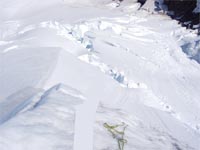Alpine ice man was bludgeoned and then shot, German experts say
 Hamburg, Germany - The famous Alpine ice man, whose 5,000-year-old mummified body was discovered in a melting glacier, was bludgeoned and then finished off with an arrow by prehistoric assailants, according to a team of German researchers.
Hamburg, Germany - The famous Alpine ice man, whose 5,000-year-old mummified body was discovered in a melting glacier, was bludgeoned and then finished off with an arrow by prehistoric assailants, according to a team of German researchers.
Adding new clues to the Stone Age riddle, the paleo-forensic scientists at Ludwig Maximilians University of Munich say they can now prove that the Oetz Valley Glacier man, dubbed Oetzi, did not die of exposure after having suffered a non-lethal blow with a blunt object, possibly a stone from a slingshot.
Instead, his attackers shot him with a flint-tipped arrow to make sure he was a goner, according to the experts.
"He only lived for a short time after the arrow impact," said Andreas Nerlich, who headed the study.
The Nerlich team studied chemical changes in living tissue to establish the sequence in which Oetzi's wounds were inflicted and which of them led to his death in the snow of the Oetz Valley Glacier in Italy's South Tyrol region.
The clues involved a deep laceration on the victim's hand, a contusion to the back, and an arrow wound in the back with an exit wound in his left armpit.
Nerlich said the hand injury showed signs of healing, indicating that it had occurred a few days prior to the man's death. In other words, it was not inflicted in the final incident which brought about Oetzi's demise.
The experts said Oetzi was probably fleeing his attackers when they hurled or fired a stone at him, wounding him and causing him to drop to his knees. Then they fired a shot with an arrow which entered his back and exited his left armpit, severing vital arteries along the way.
"Oetzi lived only a matter of minutes or an hour or so after receiving the arrow wound and the blow on the back," Nerlich said.
"At least a couple of days prior to his death, however, he sustained a severe cut wound to his right hand. Over several days, then, Oetzi suffered at least two injuring events."
Other scientists estimate Oetzi, who is now on display in the South Tyrol Archaeology Museum in Bolzano, died at age 46. His clothing and weapons offer a window into Stone Age lifestyles. (dpa)